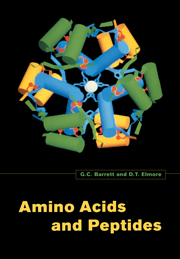Book contents
- Frontmatter
- Contents
- Foreword
- 1 Introduction
- 2 Conformations of amino acids and peptides
- 3 Physicohemical properties of amino acids and peptides
- 4 Reactions and analytical methods for amino acids and peptides
- 5 Determination of the primary structure of peptides and proteins
- 6 Synthesis of amino acids
- 7 Methods for the synthesis of peptides
- 8 Biological roles of amino acids and peptides
- 9 Some aspects of amino-acid and peptide drug design
- Subject index
4 - Reactions and analytical methods for amino acids and peptides
Published online by Cambridge University Press: 05 June 2012
- Frontmatter
- Contents
- Foreword
- 1 Introduction
- 2 Conformations of amino acids and peptides
- 3 Physicohemical properties of amino acids and peptides
- 4 Reactions and analytical methods for amino acids and peptides
- 5 Determination of the primary structure of peptides and proteins
- 6 Synthesis of amino acids
- 7 Methods for the synthesis of peptides
- 8 Biological roles of amino acids and peptides
- 9 Some aspects of amino-acid and peptide drug design
- Subject index
Summary
Part 1. Reactions of amino acids and peptides
Introduction
Part 1 of this chapter is intended to provide background material for the analytical procedures described later in this chapter for amino acids and peptides, but it also provides a broad survey of the topic that can be read in isolation from the analytical context. The derivatisation of amino acids is the basis of many of the sensitive analytical amino-acid assay procedures in current use and this chapter covers the normal profile of reactions of the amino and carboxy groups, knowledge of which is an essential prerequisite for appreciating the analytical context. Reactions of peptides are also covered here (e.g. peptide and protein hydrolysis is covered in Section 4.4.7), though the coverage is restricted in scope because parts of this topic are discussed in Chapter 5, where it is relevant to sequence-determination procedures (see also Barrett, 1985).
General survey
Many reactions with amino acids also involve the side-chain functional groups and these are generally easily understood in terms of the normal profile of reactions of the functional groups concerned. Chapter 6 deals with reactions of side-chains of amino acids, since these reactions can be exploited as a way of using one amino acid to synthesise another. Also, there are often unexpected consequences owing to the involvement of side-chain functional groups (also involvement of the amide group for peptides), when a reaction is directed either at the amino or at the carboxy group of an amino acid or a peptide.
- Type
- Chapter
- Information
- Amino Acids and Peptides , pp. 48 - 90Publisher: Cambridge University PressPrint publication year: 1998
- 4
- Cited by



